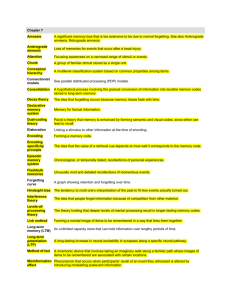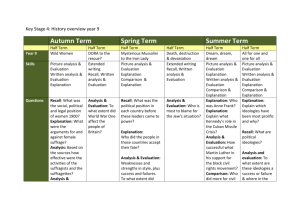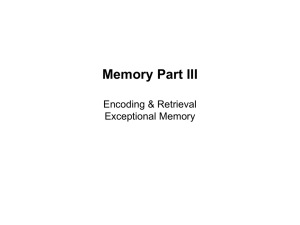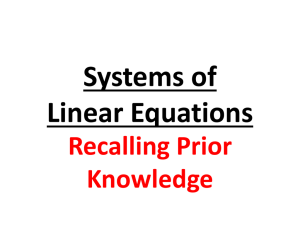Cognitive Approach Model Answers AO1 and AO2 Underlying
advertisement
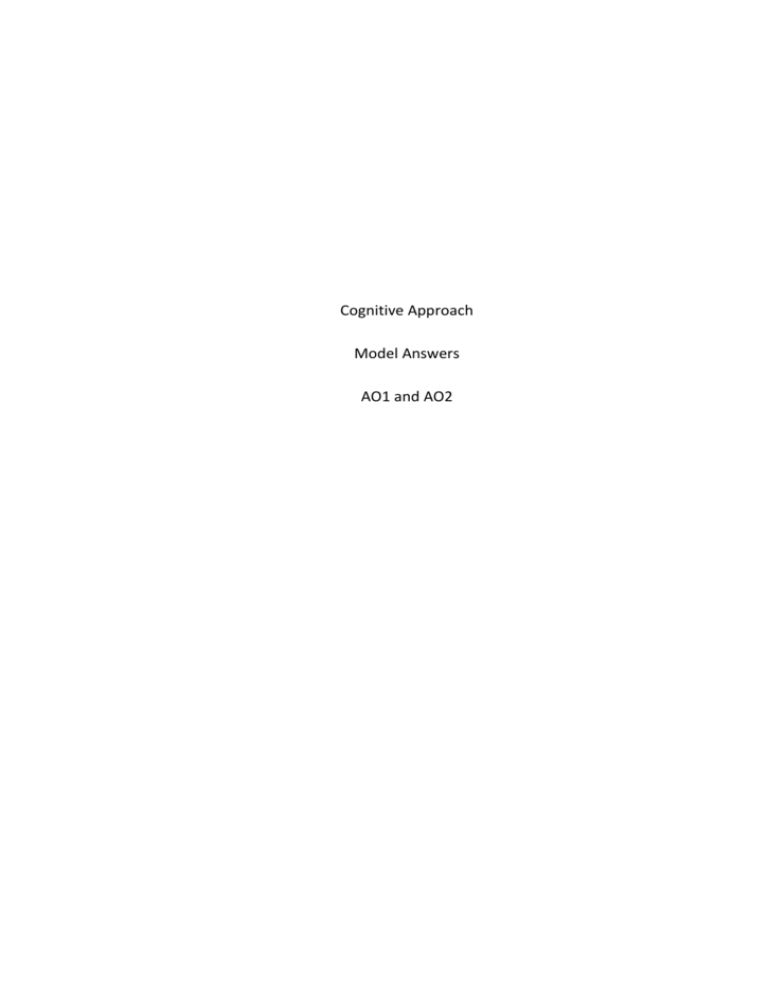
Cognitive Approach Model Answers AO1 and AO2 Underlying Concepts/Assumptions (3 AO1s) 1. Human beings are essentially highly sophisticated information processors. We selectively attend to sensory information, perceiving it as relevant/important using our long term memory, and then make decisions, both verbal and physical, seen as output. Knowledge of our actions and/or thoughts is then reinforced by internal and external feedback. 2. Human decision making can be viewed as a computer analogy. There are many similarities between the machines we have invented and the way in which the work. We both possess language, and through the internet can now communicate with each other. We both possess incredible storage space (memory) and can make calculations extremely quickly. As computers develop, we are slowly being left behind in these areas, but with emotion missing, computers will be forever our aids. The Method When evaluating an experiment from any approach, you can follow the general guidelines below The Laboratory Experiment AO1 A laboratory experiment usually takes place in an artificial environment. An independent variable (change in condition) is usually operationalised and the dependent variable (the result) is measured. Findings are analysed and a theory concluded. Internal and external variables (noise and fatigue for example) are usually controlled to avoid becoming confounding variables, which will lower internal validity. AO2 Generalisability depends on the sample of participants and the task at hand. If the former covers gender, culture and age, it is high. The cohort effect, differing generations for example, may lower generalisability. Reliability is high due to the strict controls in place. Procedure is standardised and can be easily replicated. Findings are difficult to apply outside the laboratory due to the lack of mundane reality of the task The operationalisation of the I.V and D.V can be carried out with more confidence as confounding variables are less likely to affect the findings. Internal validity is usually high. Before 1993, there were many ethical concerns surrounding experimental procedure, certainly within the Social approach. However, participants are no longer naïve, and therefore informed consent exists. Confidentiality is usually maintained and a full debrief to avoid any long lasting psychological harm is commonplace. The Studies 1. Cue Dependent Forgetting Study (Godden and Baddeley, 1975) AMPFC (5 AO1s) Ensure each point is clearly identified This study investigated the possible effect of context dependent forgetting. Their one tailed hypothesis was that recalling in the same environment as encoding would demonstrate a greater capacity than in a differing context. A repeated measures design was used where all participants (divers) were tested over a period of four days in four differing conditions; Encode on dry land and recall underwater, encode on dry and recall on dry, encode underwater and recall underwater and encode underwater and recall on dry. Simple lists of words were offered to be memorised. The mean recall was approximately 50% higher when the context remained the same for both encoding and recall. They concluded that forgetting was due to the absence of important environmental cues. AO2 Evaluate the Study GRAVE The realistic open water venue offers greater generalisability than a laboratory experiment as this was a natural environment for the trained divers. Internal reliability was questionable as noise, weather and participant variables such as fatigue were not controlled. Two of the divers were also tested at a differing venue, lowering reliability even further. Cheating was unlikely as volunteer sampling was employed and each participant is likely to have put effort into the learning and recall process. BPS ethical guidelines were followed as informed consent was offered and at any time the divers could resurface safely. One can clearly see the applicability of these findings to many areas of society, such as taking a victim back to the scene of a crime in order that environmental cues may aid recall. Learning and recalling in the same classroom has also been shown to create improved memory. 2. Levels of Processing Study (Craik and Tulving, 1975) AO1 This study was aimed at proving Tulving’s Levels of Processing theory, and whether the depth of processing would affect memory recall. 60 words were shown to 24 participants in one of three differing scenarios; structurally (whether the word was in capitals or not), phonetically (whether the word rhymed with another) and with semantic processing, deciding whether the word fitted in to a sentence. The findings showed that processing did significantly affect recall, with structural processing producing a 17% recall rate, whereas 36% of phonetically processed information was recalled and improved upon greatly as semantically processed words produced a mean average of 65%. They concluded that it was the type of processing not time spent which improved memory. AO2 Evaluate the Study GRAVE Each participant was naïve to the test as deception was evident and thus wouldn’t have aimed to practice the words for recall thus increasing overall validity. However, this was an artificial experiment and seldom would we be asked to recall in this manner. The words may also have had differing emotions connected to them for each participant, a possible confounding variable. One can see that the results being applied in classrooms as teachers aim to increase memory recall by utilising deep processing, and ensuring lesson content is processed with meaning. The Theories 1. Levels of Processing Theory (Craik and Lockhart, 1972) AO1 Memory is a by-product of the way information is processed and not a conscious action as proposed by the multi store model. We use maintenance rehearsal (shallow level) to remember items in the short term, and elaborative rehearsal (deeper level) for longer term memory. The deeper the processing (semantic) the longer the memory is encoded for. Structural processing is usually effortless and the memory forgotten quickly. Phonetic processing is at an intermediate level of processing, and dependent on the relevance of the item, may become a long term memory. AO2 This theory was supported by Craik and Tulving’s study into word recall in 1975 and Hyde and Jenkins 1973 study into the pleasantness and meaning of words, which both add credibility to the theory. Another strength over other models is that it explains why we remember certain items better than others…such as the multi store model, which cannot account for dwindling long term memories that have been rehearsed for over the prescribed one minute that Atkinson and Shiffrin put forward. Application has proven effective in the classroom, especially with the learning of foreign languages. Too reductionist a theory as many other variables appear to affect memory such as the time spent on rehearsal and the emotion attached to the event. Critical findings, such as Morris (1977) showed phonetic processing to increase the efficacy of recall over semantic, thus reducing the credibility of the theory. The theory explains conscious recall well (explicit memory) but fails to explain the occurrence of implicit, automatic recall when little processing occurs. Using imagery can also improve memory greatly, which goes against processing levels. 2. The Multi Store Model of Memory (Atkinson and Shiffrin 1968) AO1 This theory is seen as being structurally fixed with 3 main storage areas for our memories. Our sensory memory store acts as a buffer and through selective attention we filter information we deem important into our short term memory store (STM). Should this not occur then the information will be lost forever. Our STM is limited in capacity to between 59 items and requires over one minute of encoding time to become a long term memory. Through elaborative rehearsal, our long term memories are formed in a limitless store (LTM) for many years. Maintenance rehearsal (the recalling of a memory into the short term) allows this item to remain clear. AO2 There has been much support from other research with Miller (1956) supporting the limited capacity of the short term memory store and Hebb’s trace decay theory of forgetting supporting the need for maintenance rehearsal for the clear long term encoding of memory. However, the fixed structure is a little too simplistic and reductionist, not taking into account possible levels of processing or emotion. Nor does it explain why some memories which are only encoded for several seconds can last for many years. Much of the research methodology was based around the laboratory experiment which although reliable due the strict controls over the procedure lacks mundane realism and thus ecological validity. You may require a description of Reconstructive Memory proposed by Bartlett when explaining the issues with eyewitness testimony. 4 AO1s to include Schema and schemata Efforts after meaning Leading questions, prejudice and other confounding variables 3. Cue Dependent Forgetting Theory (Tulving 1974) AO1 This theory sees forgetting due to the absence of cues. Internal cues, such as level of arousal, medication or drugs are called state dependent cues, and cues from our environment, such as weather or setting are known as context dependent cues. Thus, an individual will forget more when recalling in an aggressive mood if encoding was carried out in calm mood (state dependent) and the same will occur if listening to music and recalling in the silence of an exam hall (context dependent). Tulving named this process the encoding specificity principle AO2 Credibility is high for both state and context dependent forgetting due a number of supportive studies. State here the findings of 2-3 studies for each, and how it supports (whether it is an environmental or internal cue) Irrefutability is an issue as it is impossible to test cue dependent forgetting as the cues will always exist. As usual, use other theories as alternative viewpoints. Trace decay and motivated forgetting offer other factors at work with our recall. 4. Trace Decay (Hebb) AO1 Memory changes our neural network, creating a memory trace known as an engram. Once this memory has been encoded it must be practised through continual recall otherwise it will begin to fade, known as trace decay. Forgetting occurs if the memory is readily available to work with in short term memory. Rare use and the passage of time combine to lead to partial or full forgetting. AO2 Although one of the earliest theories of why we forget, it remains relatively credible if a little simplistic. Practice of memory does appear to have a positive effect on everyday recall, and thus little practice would lead to poorer recall. However, there are several alternative viewpoints, such as cue dependency and motivated thinking, which consider the environment and emotion attached to the memory trace, rather than just the time spent on encoding. The interference theory also offers a differing view of why we lose our memory trace, emphasising our limited capacity channels, and then when similar information is encoded at the same time, recall will appear decayed. Key Issue The Reliability of Eye Witness Testimony Theories and Studies which question the above AO1 Description Eye witness testimony refers to the recalled information from long term memory into our working, short term memories. There is great debate over how reliable this information is as its significance in a court of law has diminished as more reliable forensic evidence is now used. However, eyewitness testimony can prove compelling as many of the jury may not possess the knowledge or concentration span for complex forensic evidence Issues can occur when we view memory as a dual process of encoding and recalling. Should either not produce a true and accurate memory trace then we must conclude that testimony is not reliable. Below is a balanced for and against summary. Much research has been carried out which questions the reliability of eyewitness testimony to the point of dismissing it entirely as evidence in a court of law. Famous work by Loftus on leading questions by lawyers showed that recall can be influenced greatly by the language used in questioning. Moreover, she supported the theory that memories could be falsely implanted over time. Bartlett’s early research recognised that we use need to use effort often to make memories meaningful, and as we reconstruct our memory schemata, we may use ‘best fit schemata’….essentially plugging any gaps in our memory with what on the surface appears plausible information. Prejudice often creeps in here. Cite now 2-3 other studies, and how their findings show a lack of reliability. However Research has mainly been carried out in laboratory experiments and thus lack ecological validity…here the eyewitness. Most participants were university students and thus would have been motivated in a differing way to a real life eye witness. Studies have shown that for very violent crimes vivid memories do occur. Leading questions often only affect insignificant events. Evidence of Practical A laboratory experiment AO1 and AO2 Sampling Methods Random, Self-Selecting, Volunteer, Stratified and Opportunity AO1 and AO2 Quantitative and Qualitative Data One tailed alternative hypothesis and null hypothesis Repeated measures, independent groups and matched pairs AO1 and AO2 Confounding Effects and Extraneous Variables Ethics Informed consent, deception, right to withdraw, debriefing and competence Mean, Median, Mode and Range Histograms and Comparative Bar Charts

